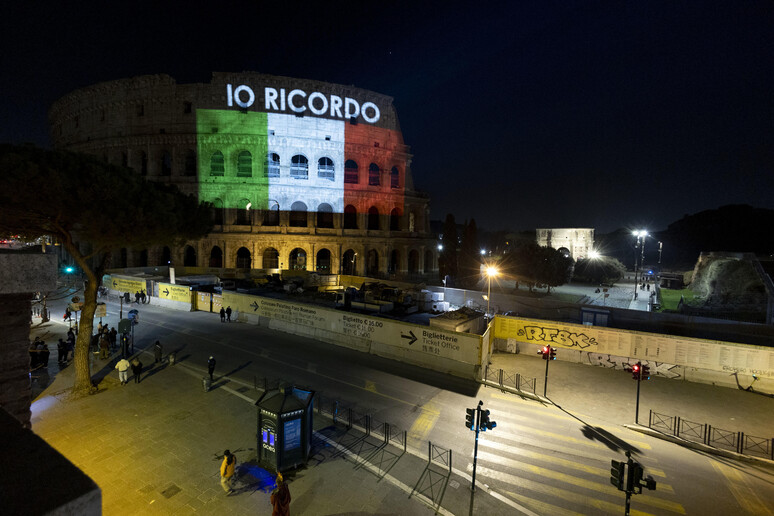(ANSA-AFP) - ROME, FEB 12 - On Saturday 10th February Italy
will mark its 20th memorial day for the World War II massacres
of thousands of Italians by Yugoslav resistance fighters, a
long-hidden tragedy that has become a political football. Since
2004, February 10 has been a national day to remember the
so-called Foibe killings, when thousands of soldiers and civil
servants working in what had been Fascist Italy were executed by
Tito's partisans, their bodies thrown into sinkholes. But Prime
Minister Giorgia Meloni's hard-right government has particularly
embraced the event, announcing last week a museum dedicated to
the victims. The day is a chance "to pay homage to the memory of
those who died at the hands of the communists", said Ignazio La
Russa, Senate speaker and co-founder of Meloni's post-fascist
Brothers of Italy party. Not everyone shares the interpretation
of La Russa -- notorious for collecting busts of the late
Fascist dictator Benito Mussolini -- of what was in fact two
rounds of killings, followed by the mass flight of Italian
speakers from what became Yugoslavia, then Slovenia and Croatia.
The first massacre came in 1943, after Nazi Germany's ally Italy
signed an armistice with the US and Britain. Historian Eric
Gobetti said it was "a consequence of violence committed by the
Italian Fascists against the Yugoslav national minority,
Slovenians and Croats, who after the capitulation of Italy, took
revenge". The reprisals were "not against all Italians but some
Italians who represented the Fascist state", Gobetti, an author
of a book on the Foibe, told AFP. The second massacre in 1945,
after the end of the war, was more akin to a "settling of
accounts" between the Yugoslav forces who freed the territory
and those who fought alongside the Nazis, as was also seen in
France, he said. "The victims were essentially collaborators
with the Germans, civilians but above all military," Gobetti
said. Whereas the prevailing narrative in Italy is that the
Italians were wholly innocent victims, Gobetti and other
historians emphasise how the Fascist regime abused minorities in
the region.
- 'Climate of violence' -
The experts also contest the numbers of people who died in
Foibe, named after the Italian word for sinkholes into which the
victims were thrown, sometimes alive. Gobetti said a "maximum of
5,000" people were killed, while the Federesuli, an Italian
association representing the exiles of the time, claims a number
between 6,000 and 10,000. A similar divergence exists in
estimates of how many people were displaced after the post-war
border changes, when Italy lost territories acquired in World
War I. For historians, around 250,000 people were exiled,
whereas for the Federesuli, it was 350,000. "Some 90 percent of
the native Italian community left because of the climate of
violence imposed by Tito's communist regime", finding themselves
living in refugee camps set up by Italy, said Lorenzo Salimbeni,
a spokesman for Federesuli.
- Fascism nostalgia -
Why the different views? "Politicians nostalgic for Fascism have
always exploited this story to present themselves as victims of
WWII instead of executioners, when in fact the Italian Fascists
contributed to starting the war," said Gobetti. This narrative
was enshrined in the 2004 law setting up the national memorial
day -- passed under the government of Silvio Berlusconi, but
backed by opposition parties -- and taken up by the media. In
this context, "anyone who remembers the actual historic facts is
considered to be denying the Foibe" -- while in some debates,
the massacres are put on the same level as the Holocaust,
Gobetti said. Salimbeni of the exiles' association welcomed news
of the new museum to the Foibe, which he said followed work of
previous governments "of left and right". But this
reinterpretation of history in Italy has sparked outrage among
its neighbours. In 2019, Slovenia accused Rome of "unprecedented
historical revisionism" over the massacres. It was speaking
after then-Interior Minister Matteo Salvini -- now Meloni's
deputy prime minister -- compared the children who died in the
Foibe to those who died at Auschwitz. "Fascism was a fact and
its objective was destroying the Slovenian people," Slovenia's
then-premier Marjan Sarec said. (ANSA-AFP).
ALL RIGHTS RESERVED © Copyright ANSA





